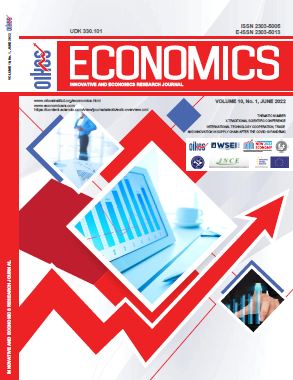DOES IT MATTER FOR CBDC DESIGN? PRIVACY-ANONYMITY PREFERENCES FROM THE SIDE OF HIERARCHIES AND EGALITARIAN CULTURAL PATTERNS
DOI:
https://doi.org/10.2478/eoik-2022-0008Keywords:
CBDC design, digital money, cultural attitudes, privacy, anonymity.Abstract
Evolution of digital money demonstrates that CBDC (Central Bank Digital
Currency means a digital form of traditional fiat currencies) design is really
challenging. While technically possible CBDC solutions are visible, much of
institutional aspects are rest to be unsolved. One of the issues is a degree of
privacy and anonymity. All historical forms of money had intrinsic property of
non-traceability of transactions and only now this feature of non-digital money
is recognized as strong institutional advance. At the same time, privacy and
anonymity preferences could relate to cultural attitudes. However, money may
distort expected logical relations between such patterns like “less hierarchies
more privacy-anonymity” or “more egalitarianism less privacy-anonymity”.
This potentially means that money may posit extra propensity to privacyanonymity
that is going beyond the cultural attitudes. Basing on the survey, we
demonstrate some contradictions in how respondents perceive the preference
of functional usability over anonymity of transactions. The same is relevant
when cultural patterns are taken into account. It is more likely to find cultural
closeness across respondents from different regions than strong determinacy of
privacy-anonymity preferences by propensity to hierarchies or egalitarianism.
Additionally, we checked hierarchies or egalitarianism attitudes by additional
questions and found some mixed results. Also, we found some conformism
culture (meaning unstable preferences) and rely it with lack of trust in public
institutions. When centralized money are less trusted people faster agree to
sacrifice anonymity in the benefits of functionality. The main take away is that it
is unlikely to expect the unity of optimal CBDC design across countries. Aside of
behavioural distortions, culture still matter and it is likely to expect future variety
of digital money from functional usability privacy-anonymity trade-off.
References
Acquisti A., Taylor C., Wagman L. (2016). The Economics of Privacy. Journal of Economic Literature. 54(2), 442-492.
https://doi.org/10.1257/jel.54.2.442
Agur, I., Ari, A., & Dell’Ariccia, G. (2019). Designing Central Bank Digital Currencies (IMF Working Paper No. WP/19/252) (1-38).
Retrieved from: https://papers.ssrn.com/sol3/papers.cfm?abstract_id=3523125
https://doi.org/10.1108/JMLC-11-2021-0126
Alfonso V., Kamin S., Zampolli F. (2022). Central Bank Digital Currencies (CBDCs) in Latin America and the Caribbean. BIS Working Paper. №989. 1-44.
Athey S., Catalini C., Tucker C. (2017). The Digital Privacy Paradox: Small Money, Small Costs, Small Talk. NBER Working Paper. №23488. 1-34. Retrieved from: https://www.nber.org/system/files/working_papers/w23488/w23488.pdf
Auer R., Cornelli G. Frost J. (2020). Rise of Central Bank Digital Currency: Drivers, Approaches and Technologies. BIS Working Paper. №880 (1-44). Retrived from: https://www.bis.org/publ/work880.pdf
Auer R., Frost J., Gambacorta L., Monnet C., Rice T., Shin H. S. (2021). Central Bank Digital Currencies: Motives, Economic Implications and Research Frontier. BIS Working Paper. №976. 1-30.
https://doi.org/10.2478/eoik-2021-0019
Borgonovo E., Caselli S., Cillo A., Masciandaro D., Rabitti G. (2021). Money, Privacy, Anonymity: What Do Experiments Tell Us? Journal of Financial Stability. Vol. 56.
https://doi.org/10.1016/j.jfs.2021.100934
Borio, C. (2019). On Money, Debt, Trust, and Central Banking. BIS Working Paper №763.
Retrieved from:
https://www.bis.org/publ/work763.htm
Croxson K., Frost J., Gambacorta L., Valletti T. (2022). Platform-Based Business Models and Financial Inclusion. BIS Working Paper. №986. рр. 1-33.
European Central Bank (2019). Exploring Anonymity in Central Bank Digital Currencies. ECB. In Focus №4. 1-11.
European Central Bank (2021). Eurosystem report on the public consultation on a digital euro.
April 2021.
Falicov S. (2001). Ethnicity and the Meaning of Money and Property. American Behavioral Scientist, 45 (2), 313-328.
Grothoff Ch., Moser T. (2021). How to Issue Privacy-Preserving Central Bank Digital Currency.
SUERF Policy Briefs №114. 1-6.
Guiso L., Sapienza P., Zingales L. (2006). Does Culture Affect Economic Outcomes? Journal of Economic Perspectives. 20 (2). 23-48.
https://doi.org/10.1257/jep.20.2.23
Halaburda, H., Haeringer, G., Gans, J. S., and Gandal, N. (2020). The Microeconomics of Cryptocurrencies. (NBER Working Papers No. 27477). Retrieved from: https://www.nber.org/system/files/working_papers/w27477/w27477.pdf
Henchoz C., Coste T., Wernli B. (2019). Culture, Money Attitudes, and Economic Outcomes. Swiss Journal of Economics and Statistics. 155 (2). 1-13.
https://doi.org/10.1186/s41937-019-0028-4
Jong de E. (2002). Why Are Price Stability and Statutory Independence of Central Banks Negatively Correlated? The Role of Culture. European Journal of Political Economy. 18((4). 675-694.
https://doi.org/10.1016/j.jfs.2021.100934
Jost A. (2018). Cultural Differences in Monetary Policy Preferences. Swiss National Bank Working paper. 2/2018. 1-46.
Kahn Ch., McAndrews J., Roberds W. (2004). Money is Privacy. Federal Bank of Atlanta Working Paper 2004-18. 1-23.
Kocherlakota, N. (1996). Money is Memory. Research Department Staff Report No. 218. Federal Reserve Bank of Minneapolis.
Retrieved from: https://www.minneapolisfed.org/research/staff-reports/money-is-memory
Kocherlakota, N. (1998). Money is Memory. Journal of Economic Theory, 81(2), 232-251.
https://doi.org/10.1006/jeth.1997.2357 https://doi.org/10.1017/S1365100515000541
Koziuk V. (2021). Confidence in digital money: Are central banks more trusted than age is matter? Investment Management and Financial Innovations, 18 (1), 12-32.
http://dx.doi.org/10.21511/imfi.18(1).2021.02
Koziuk V. (2021). Willingness to adopt digital currency: whether central bank independence is important. Finance of Ukraine, 3, 7-22.
https://doi.org/10.33763/finukr2021.03.007
Li Y., Kobsa A., Knijnenburg B., Nguyen C. (2017). Cross-Cultural Privacy Predictions. Proceedings on Privacy Enhancing Technologies 3 (2). 1-20.
https://doi.org/10.1515/popets-2017-0019
Mancini-Griffoli, T., Martinez Peria, M. S., Agur, I., Ari, A., Kiff, J., Popescu, A., &Rochon, C. (2018).
Casting Light on Central Bank Digital Currency (IMF Staff Discussion Notes
No. 18/08). Retrieved from:
https://www.imf.org/en/Publications/Staff-Discussion-Notes/Issues/2018/11/13/Casting-
Light-on-Central-Bank-Digital-Currencies-46233
Masciandaro D. (2018). Central Bank Digital Cash and Cryptocurrencies: Insights from Baumol-Friedman Demand for Money. Australia Economic Review. 51 (4). 1-11.
https://doi.org/10.1111/1467-8462.12304
Omrani N., Soulié N. (2017): Culture, Privacy Conception and Privacy Concern: Evidence from Europe before PRISM, 14th Asia-Pacific Regional Conference of the International Telecommunications Society (ITS): “Mapping ICT into Transformation for the Next Information Society”, Kyoto, Japan, 24th-27th June, 2017, International Telecommunications Society (ITS), Calgary
Schnabel, I., & Shin, H. S. (2004). Liquidity and Contagion: The Crisis of 1763. Journal of the European Economic Association, 2 (6), 1-40.
https://doi.org/10.1162/1542476042813887
Schnabel, I., & Shin, H. S. (2018). Money and Trust: Lessons from the 1620s for Money in the Digital Age BIS Working Paper No. 698. Retrieved from: https://www.bis.org/publ/work698.html
Tognato C. (2012). Central Bank Independence. Cultural Codes and Symbolic Performance. Palgrave MacMillan. NY.
Trepte S., Reinecke L., Ellison N., Quiring O., Yao M., Ziegele M. (2017). A Cross-Country Perspective on Privacy Calculus. Social Media + Society, 3 (1), 1-13.
https://doi.org/10.1177/2056305116688035
Vaz, J., & Brown, K. (2020). Money Without Institutions, How Can Cryptocurrencies be Trusted? Paper presented on Financial Engineering and Banking Society Conference. Prague.
Retrieved from: https://www.efmaefm.org/0EFMAMEETINGS/EFMA%20ANNUAL%20MEETINGS/2020-Dublin/papers/EFMA%202020_stage-1301_question-Full%20Paper_id-207.pdf
World Economic Forum (2021). Privacy and Confidentiality of Central Bank Digital Currency. White Paper. November 2021.
Zanini, M., & Migueles, C. (2013). Trust as an Element of Informal Coordination and its Relationship with Organizational Performance. EconomiA, 14(2), 77-87.
https://doi.org/10.1016/j.econ.2013.08.005
Zelizer, V. (1994). The Social Meaning of Money. NY.: Basic Books.
Zucker, L. (1986). Production of Trust: Institutional Sources of Economic Structure, 1840-1920. Research in Organizational Behavior, 8, 53-111. Retrieved from: https://psycnet.apa.org/record/1988-10420-001
Kuhn, M., & Johnson, K. (2013). Applied Predictive Modeling. New York: Springer.
Downloads
Published
How to Cite
Issue
Section
License
Copyright (c) 2022 ECONOMICS - INNOVATIVE AND ECONOMICS RESEARCH JOURNAL

This work is licensed under a Creative Commons Attribution-NonCommercial-NoDerivatives 4.0 International License.























